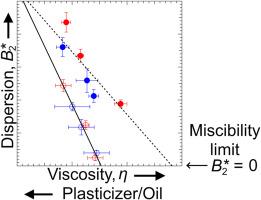Impact of melt viscosity on filler dispersion in elastomeric nanocomposites
IF 4.1
2区 化学
Q2 POLYMER SCIENCE
引用次数: 0
Abstract
Compounding of commercial nanocomposites usually involves the addition of viscosity enhancers such as binder resins in ink jet inks, and paints. Contrary to this, plasticizers such as process oils are added to reduce the melt viscosity and ease processability of reinforced elastomers. Nanofillers such as silica and carbon black are typically added to reinforce rubber and enhance performance of automotive tire treads. Filler dispersion has traditionally been qualitatively (indirectly) assessed by measuring the properties of reinforced elastomers. While dispersion can be quantified by examining filler agglomeration through surface roughness measurements and microscopy, the size-scale dependence for these hierarchical fillers has usually been ignored. We have recently devised a method to quantify nano-scale dispersion of fillers using Ultra small-angle X-ray scattering (USAXS) techniques. This method is advantageous since it directly links the controllable processing/compounding parameters such as the mixing speed, mixer geometry, residence time (or mixing duration), melt density, flow gap distance, and melt viscosity to nano-scale dispersion. While our previous studies have explored the impact of different processing parameters, this study specifically investigates the impact of melt viscosity on nano-scale filler dispersion in elastomer compounds. Commercially available polybutadienes with different Mooney viscosities were used in conjunction with different grades and amounts of process oils to modify the melt viscosity.


求助全文
约1分钟内获得全文
求助全文
来源期刊

Polymer
化学-高分子科学
CiteScore
7.90
自引率
8.70%
发文量
959
审稿时长
32 days
期刊介绍:
Polymer is an interdisciplinary journal dedicated to publishing innovative and significant advances in Polymer Physics, Chemistry and Technology. We welcome submissions on polymer hybrids, nanocomposites, characterisation and self-assembly. Polymer also publishes work on the technological application of polymers in energy and optoelectronics.
The main scope is covered but not limited to the following core areas:
Polymer Materials
Nanocomposites and hybrid nanomaterials
Polymer blends, films, fibres, networks and porous materials
Physical Characterization
Characterisation, modelling and simulation* of molecular and materials properties in bulk, solution, and thin films
Polymer Engineering
Advanced multiscale processing methods
Polymer Synthesis, Modification and Self-assembly
Including designer polymer architectures, mechanisms and kinetics, and supramolecular polymerization
Technological Applications
Polymers for energy generation and storage
Polymer membranes for separation technology
Polymers for opto- and microelectronics.
 求助内容:
求助内容: 应助结果提醒方式:
应助结果提醒方式:


